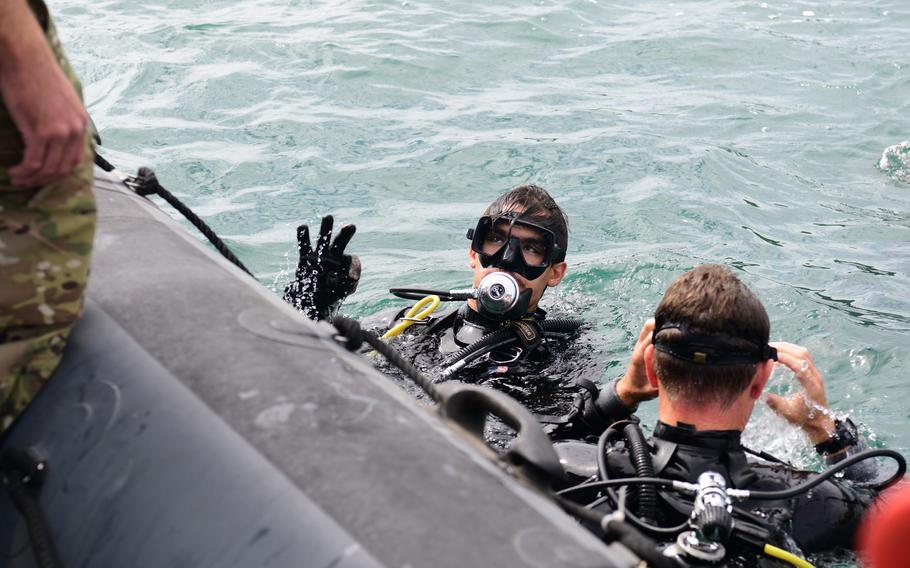
Sailors assigned to Explosive Ordnance Disposal Mobile Unit 8 conduct emergency action plan drills with the Bulgarian, Japanese and Ukrainian dive teams while underway off the coast of Varna, Bulgaria as part of Sea Breeze 2024, Sept. 10, 2024. (Novalee Manzella/U.S. Navy)
NAPLES, Italy — More than 100 mines have been spotted by U.S. military reconnaissance aircraft and allies in the Black Sea since Russia’s full-scale invasion of Ukraine more than two years ago, the commanding officer of U.S. 6th Fleet said this week.
Russian mines have been used primarily near Ukrainian ports. But they remain a long-term concern for the nations that share the sea’s commercial shipping lanes, as well as for the potential danger to tourists and others closer to shore.
The 6th Fleet confirmed Wednesday that the U.S. flights have been taking place over Bulgarian and Romanian waters for more than a year, following comments by Vice Adm. Thomas Ishee at the multinational Sea Breeze naval exercise in Varna, Bulgaria on Monday.
Ishee didn’t specify the types of aircraft used for the flights or the service involved. He did say the flights are part of collective efforts, which have found 105 floating mines in the Black Sea since 2022.
Mines have affected at least five ships traveling in the sea over that same period, Ishee said, as quoted by the Bulgarian News Agency on Monday. He didn’t specify the vessels or any resulting damage.
The final drills of the 23rd iteration of Sea Breeze started Monday. The exercise is focused on detecting and clearing sea mines, among other objectives, 6th Fleet said in a statement Tuesday. Sea Breeze ends Sept. 20.

Vice Adm. Thomas Ishee, commander, U.S. 6th Fleet, left, and Rear Adm. Kiril Mihaylov, commander of the Bulgarian navy, speak to reporters in Varna, Bulgaria during the Sea Breeze exercise, Sep. 10, 2024. (Novalee Manzella/U.S. Navy)
The first part of the exercise took place in June and July near Scotland. The second and third parts are in Bulgaria, with some 12 countries, including Estonia, France, Greece, Italy, Japan, Romania, Sweden, Turkey and Ukraine participating. It also includes NATO Maritime Command, according to the statement.
Early in the war, a Russian naval blockade effectively kept Ukrainian grain stuck in port. A subsequent deal allowed for exports of grain, food and other goods from Ukraine through a safe travel corridor in the Black Sea. But the Kremlin pulled out of the agreement in July 2023.
That same month, U.S. officials warned that Russia was laying sea mines on the approaches to Ukrainian ports to expand its attack on the country’s grain facilities, Reuters reported at the time.
In response, Ukraine has used drone and missile attacks to destroy or disable about one-third of the Russian Black Sea Fleet, making it difficult for Russia to resume a maritime blockade.
Income from the sale of wheat, barley and other grains and seeds helps shore up Ukraine’s finances for the war effort. Blocking their export opens a greater share of the global grain market to Russia, analysts have said.
Meanwhile, U.S. allies are worried about the safety and trade impacts to their countries. Those fears are well-grounded.
In December 2023, a Panama-flagged cargo ship hit a mine near Ukraine. The explosion injured two mariners and damaged mechanical and electrical systems, causing the vessel to lose speed and control, Reuters reported at the time.
About a month later, Turkey, Bulgaria and Romania announced a joint plan to clear mines from the Black Sea.

Petty Officer 2nd Class Grant Jones, assigned to Patrol Squadron 45, works aboard a P-8A Poseidon aircraft during an exercise July 9, 2024 over the Black Sea. (Jonathan D. Berlier/U.S. Navy)
During Sea Breeze, participants also will do explosive ordnance disposal, dive operations and underwater drone exercises. They’ll discuss the mine threat, collective demining capabilities and ways to enhance regional maritime security, 6th Fleet said.
“The mine countermeasures and explosive ordnance disposal training we’re doing with our Allies and partners during Sea Breeze 2024 directly supports freedom of navigation in the contested Black Sea region,” Ishee said in the statement Tuesday.